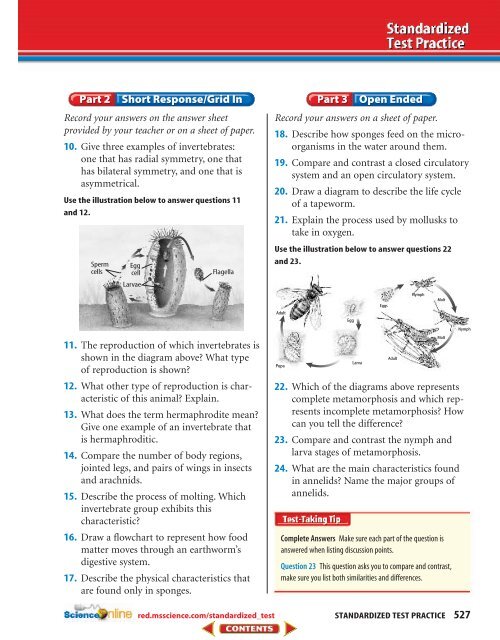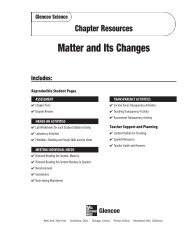Chapter 17: Invertebrate Animals
Chapter 17: Invertebrate Animals
Chapter 17: Invertebrate Animals
Create successful ePaper yourself
Turn your PDF publications into a flip-book with our unique Google optimized e-Paper software.
Record your answers on the answer sheet<br />
provided by your teacher or on a sheet of paper.<br />
10. Give three examples of invertebrates:<br />
one that has radial symmetry, one that<br />
has bilateral symmetry, and one that is<br />
asymmetrical.<br />
Use the illustration below to answer questions 11<br />
and 12.<br />
Sperm<br />
cells<br />
Egg<br />
cell<br />
Larvae<br />
Flagella<br />
11. The reproduction of which invertebrates is<br />
shown in the diagram above What type<br />
of reproduction is shown<br />
12. What other type of reproduction is characteristic<br />
of this animal Explain.<br />
13. What does the term hermaphrodite mean<br />
Give one example of an invertebrate that<br />
is hermaphroditic.<br />
14. Compare the number of body regions,<br />
jointed legs, and pairs of wings in insects<br />
and arachnids.<br />
15. Describe the process of molting. Which<br />
invertebrate group exhibits this<br />
characteristic<br />
16. Draw a flowchart to represent how food<br />
matter moves through an earthworm’s<br />
digestive system.<br />
<strong>17</strong>. Describe the physical characteristics that<br />
are found only in sponges.<br />
Record your answers on a sheet of paper.<br />
18. Describe how sponges feed on the microorganisms<br />
in the water around them.<br />
19. Compare and contrast a closed circulatory<br />
system and an open circulatory system.<br />
20. Draw a diagram to describe the life cycle<br />
of a tapeworm.<br />
21. Explain the process used by mollusks to<br />
take in oxygen.<br />
Use the illustration below to answer questions 22<br />
and 23.<br />
Adult<br />
Pupa<br />
Egg<br />
Larva<br />
22. Which of the diagrams above represents<br />
complete metamorphosis and which represents<br />
incomplete metamorphosis How<br />
can you tell the difference<br />
23. Compare and contrast the nymph and<br />
larva stages of metamorphosis.<br />
24. What are the main characteristics found<br />
in annelids Name the major groups of<br />
annelids.<br />
Eggs<br />
Adult<br />
Nymph<br />
Complete Answers Make sure each part of the question is<br />
answered when listing discussion points.<br />
Question 23 This question asks you to compare and contrast,<br />
make sure you list both similarities and differences.<br />
Molt<br />
Molt<br />
Nymph<br />
red.msscience.com/standardized_test<br />
STANDARDIZED TEST PRACTICE 527














